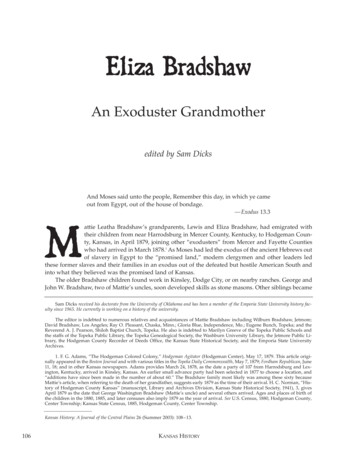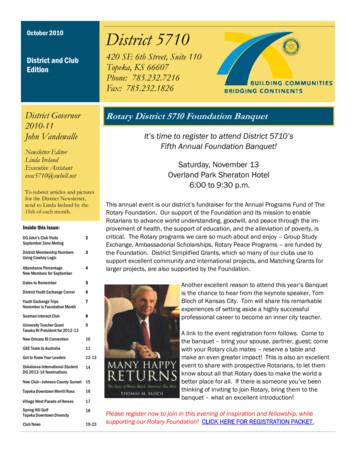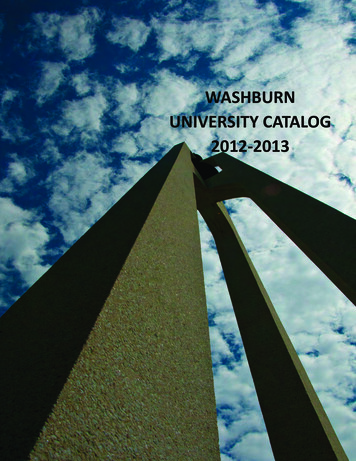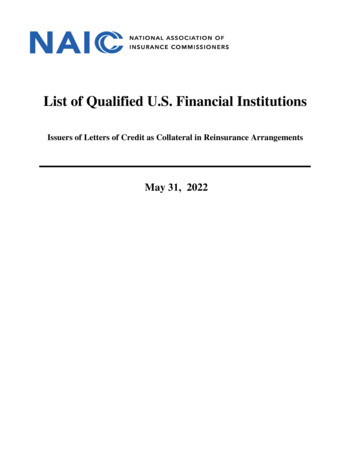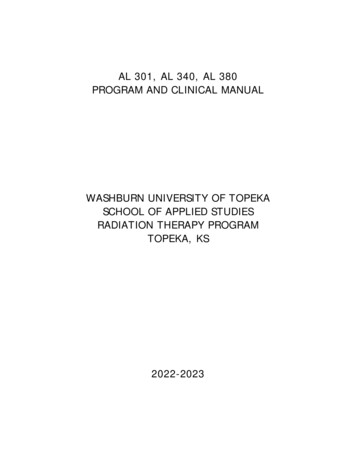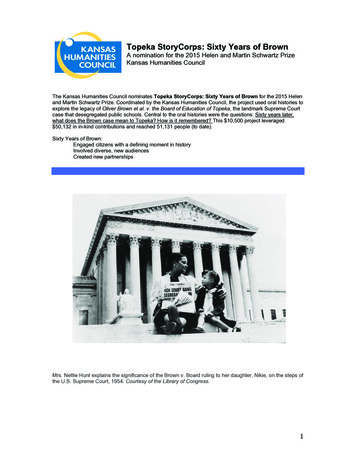
Transcription
Topeka StoryCorps: Sixty Years of BrownA nomination for the 2015 Helen and Martin Schwartz PrizeKansas Humanities CouncilThe Kansas Humanities Council nominates Topeka StoryCorps: Sixty Years of Brown for the 2015 Helenand Martin Schwartz Prize. Coordinated by the Kansas Humanities Council, the project used oral histories toexplore the legacy of Oliver Brown et al. v. the Board of Education of Topeka, the landmark Supreme Courtcase that desegregated public schools. Central to the oral histories were the questions: Sixty years later,what does the Brown case mean to Topeka? How is it remembered? This 10,500 project leveraged 50,132 in in-kind contributions and reached 51,131 people (to date).Sixty Years of Brown:Engaged citizens with a defining moment in historyInvolved diverse, new audiencesCreated new partnershipsMrs. Nettie Hunt explains the significance of the Brown v. Board ruling to her daughter, Nikie, on the steps ofthe U.S. Supreme Court, 1954. Courtesy of the Library of Congress.1
Project Background: Understanding the Brown v. Board decision“We come then to the question presented:Does segregation of children in public schools solely on the basis of race, even thoughthe physical facilities and other ‘tangible’ factors may be equal, deprive the children ofthe minority group of equal educational opportunities?We believe that it does.”U.S. Supreme Court ruling on Brown v. Board of Education, May 1954In May of 1954, the U.S. Supreme Court decision in Oliver Brown et al. v. the Board of Education of Topekachanged the course of American history. According to the Brown v. Board of Education National Historic Sitein Topeka, KS, “Often when people think of the case, they remember a little girl whose parents sued so thatshe could attend an all-white school in her neighborhood. In reality, the story of Brown v. Board of Educationis far more complex.”For Topeka, the case began long before 1954. Since the passing of a Kansas law in 1879 that permittedracially segregated elementary schools in certain cities based on population, eleven cases had been filed.The Brown case would be the twelfth.Initiated in 1950 by the local NAACP chapter in Topeka, thirteen parents volunteered to participate. Thatsummer, they took their children to their neighborhood schools and attempted to enroll them for theupcoming school year. All were refused admission. The children would have to attend one of only fourschools in the city for African Americans and, for most, this involved traveling some distance from theirhomes. On behalf of their children, the parents filed suit against the Topeka Board of Education. OliverBrown, a minister, was the first parent listed in the suit.The case was filed in February 1951. The U.S. District Court ruled against the plaintiffs, but placed in therecord its acceptance of the psychological evidence that children were adversely affected by segregation.The U.S. Supreme Court would ultimately quote this finding in its 1954 opinion.By December of 1952, the U.S. Supreme Court had on its docket cases from Kansas, Delaware, the Districtof Columbia, South Carolina, and Virginia, all challenging the constitutionality of racial segregation in publicschools. The five were consolidated under one name, Oliver Brown et al. v. the Board of Education ofTopeka.After hearing the case, the Supreme Court justices were unable to come to a decision by June 1953, theend of the Court's 1952-1953 term. The case was retried in December of 1953 and, by then, the justiceswere unanimous in their decision. Chief Justice Earl Warren delivered the opinion of the court in May 1954:"We conclude that in the field of public education the doctrine of 'separate but equal'has no place. Separate educational facilities are inherently unequal. . ."Since then, historians have worked tirelessly to preserve the stories of the attorneys and plaintiffs involved inthe Brown v. Board case. In addition, in 1992, President George H.W. Bush signed the Brown v. Board ofEducation National Historic Site Act establishing the Monroe Elementary School in Topeka as a nationalpark. Today, the site interprets the Brown decision and its legacy.2
Project Description: Involvement by the Kansas Humanities CouncilAfter a meeting with city leaders in the fall of 2013 to consider ways Topeka could commemorate the 60thanniversary of Brown v. Board, the Kansas Humanities Council realized core questions had yet to beanswered: Sixty years later, how is Brown v. Board remembered by Topekans? What does the Brown v. Board case mean to residents today?It was time to find and save the personal stories of Topekans affected by the decision but not necessarilyinvolved in the decision.To be successful in finding these stories, the Kansas Humanities Council needed strong, community-mindedlocal cultural organizations as partners. As a result, KHC developed key new relationships with the Topekaand Shawnee County Public Library and the Brown v. Board of Education National Historic Site, andtogether identified three goals for the Sixty Years of Brown project:1) To preserve personal stories to broaden the understanding of the impact of the Brown decision2) To use contemporary oral histories for improved interpretation, school tours, and public programs3) To keep the history of the Brown v. Board case relevant for Topekans of all agesThis partnership resulted in a three-day oral history project in Topeka from May 1-3, 2014. Thirty-six Topekaresidents – some recruited, while others volunteered – provided the foundation for the development of abrand-new oral history archive consisting of stories from local residents about post-Brown Topeka. The oralhistories were conducted by StoryCorps, the national nonprofit organization whose mission is to record,share, and preserve the stories of our lives.For three days, Topekans told stories to one another about their school experiences, perspectives,friendships, hardships, and life in Topeka post-Brown. On the evening before the interviews were to begin,the three organizations hosted a reception and training session at the Brown v. Board of Education NationalHistoric Site. Part instruction, part fellowship, the evening allowed interviewees to meet the StoryCorpsfacilitators, share memories, and build a sense of community and camaraderie.A few examples of Stories Shared during Sixty Years of BrownBill Bunten and Jack AlexanderIn the 1940s, Alexander played basketball for the Topeka HighRamblers, the segregated African American basketball team whileBunten played for the all-white Topeka High Trojans. Both lifelongTopekans, Bunten later became mayor while Alexander was the city’sfirst African American city council member. Bunten interviewedAlexander about his school experiences and life in Topeka both pre- andpost-Brown.Joyce Revely and Eric McHenryEric McHenry, a Washburn University English professor and Topekanative, interviewed family friend Joyce Revely. For generations, Revely’sfamily has lived in the Tennessee Town neighborhood, a historic AfricanAmerican community in Topeka. Revely’s son, Wesley, was McHenry’sbest friend before he died from complications related to sickle cellanemia. Revely talked with McHerny about her experience growing up inTopeka.Kelsie Gonzalez and Katherine SawyerGonzalez interviewed Sawyer, her grandmother. Sawyer discussed herchildhood experience of the long, crowded bus rides to segregatedschools. She also talked about what it was like to testify during the Brownv. Board trial, the only child called to do so. Her granddaughter providedinsight into the contemporary experience of blacks in Topeka andcontinuing challenges.3
Dale Cushinberry and J.B. BauersfeldJ.B. Bauersfeld interviewed his former high school principal, DaleCushinberry. Cushinberry discussed the African American communitypre-and post- Brown and how it felt to attend a newly integrated school.Bauersfeld spoke about his experience going to school in the 1990s atHighland Park, a predominantly African American school in Topeka.Madison Wallace and Darren CanadyDarren Canady, English professor at the University of Kansas andTopeka High alum, interviewed Madison Wallace, a graduating senior in2014. Wallace is a theater enthusiast and Canady is an accomplishedplaywright. The two compared their high school experiences in Topeka,and explored how race and integration continue to be a part of theeducation system and Topeka’s social structure.Duane Pomeroy and Janel JohnsonDuane Pomeroy, a former USD 501 school board member, interviewedJanel Johnson, current USD 501 school board president. As a schoolboard member in the 1980s, Pomeroy was listed as the defendant in aclass action lawsuit against the district for failure to comply with therequirements of Brown v. Board. The case was nicknamed Brown 2. Thetwo talked about their roles as school board president and theirexpectations for the future.Pastor T.D. Hicks and Pastor Tobias SchlingensiepenTobias Schlingensiepen, a pastor at the First Congregational Church,interviewed T.D. Hicks, pastor at the Antioch Missionary Baptist Churchin Topeka. The two have taken on several projects together to addresspersistent challenges of issues of race in Topeka.The stories are now archived in the Library of Congress in Washington DC, the Topeka Shawnee CountyPublic Library, and the Brown v. Board of Education National Historic Site. The two local organizations willuse the interviews for future public programs, listening parties, exhibitions, teacher seminars, and expandedcurriculum for classroom use.Kansas Public Radio also received copies of the interviews, edited them into two-minute episodes, and airedtwelve of the eighteen during the winter months of 2015. The edited interviews will soon be on the KHCwebsite while all resources will be made easily available for schoolchildren, teachers, researchers, and thegeneral public. The findings, and importance of these reactions, will resonate nationwide.4
Public Impact: Numbers and AnecdotesA summary of the number of people involved in the Sixty Years of Brown project:Oral History InterviewsTraining and Opening receptionInterview on I’ve Got Issues program, KTWU local public televisionInterview on Central Standard program, KCUR Kansas City Public RadioFeature on Sunflower Journeys program, KTWU local public televisionFeature on KPR Presents program, Kansas Public RadioTwelve weeks of Topeka StoryCorps on Kansas Public RadioTotal reach (so far)364516,0008,00016,00085010,20051,131Anecdotal evidence of impact:“I think the legacy of this project is that we took the temperature of our community. Wegained a clearer understanding of people living in the era of Brown – the inside story –but also a clearer understanding 60 years later. By making Sixty Years of Brown anintergenerational project, we were able to capture the then and now about Topeka. Thistemperature check will serve us again when we reconsider in the future how little or farwe as a community have progressed.”Donna Rae Pearson, Local History Librarian, Topeka and Shawnee County Public Library“The project gave us new knowledge about the everyday life of Topeka during the timeof Brown v. Board of Education and after Something I could not find or read about inany text. I could hear the emotion in their voices and I heard stories that have neverbeen recorded in history books. I have a new perspective and one that I will be able toshare with visitors.”Nick Murray, Education Specialist, Brown v. Board of Education National Historic SiteIn what was arguably the most important Supreme Court decision of all time, Topekahelped break down barriers of hate, ignorance, and bigotry to create a better world. Ourparticipation [in this project] should [be] a constant reminder that the struggle for equalityfor all is not a battle that is ever won but an approach to life we all must continue topursue ”Nathan Schmidt, Topeka city council member“This [Topeka] StoryCorps series [on Kansas Public Radio] is the best thing to havehappened among archives, libraries, museums, and the general public since theadoption of the Dewey Decimal system – lmho. Whoever developed this idea isdeserving of greater public acknowledgement and praise. I am convinced within thesememories is a formula which can lead humanity away from more violentcommunication and toward an elevating dialog it could happen could too.”Mike Watow, Facebook post, after a Topeka StoryCorps interview aired, Winter 20155
Financial StructureBringing StoryCorps to Topeka was the major expense for the Sixty Years of Brown project. For three daysof interviews, StoryCorps charged 10,500. The Kansas Humanities Council was the fundraiser for theproject and raised the needed funds from Topeka business, foundations, and individuals. Outside fundingwas secured from local businesses and organizations:Security BenefitCapitol Federal FoundationGreater Topeka FundWestar EnergyFairlawn Plaza Shopping MallTopeka & Shawnee County Public LibraryBrown v. Board National Historic SitePrivate ContributionsTotal raised 2,500 2,100 1,500 1,000 1,000 1,000 1,000 453 10,553Cost Share BreakdownThe four partner organizations donated staff, time, and resources including facilities, equipment, the openingreception, supplies, training, publicity, and promotions:Kansas Humanities CouncilTopeka & Shawnee County Public LibraryBrown v. Board National Historic SiteKansas Public RadioCost Share Total 6,105 4,417 3,310 36,300 50,132In conclusion:The Brown v. Board of Education decision is a defining moment in American history.Although Topeka is the city most closely associated with the 1954 decision, the legacyand obligations of Brown belong to all Americans. The Kansas Humanities Council washonored to create, develop, and coordinate this project and to do our part to keep thesignificance and relevance of the Brown decision on the minds of today’s Kansans. SixtyYears of Brown encouraged important, personal discussions about race and illuminatedthe conditions of contemporary life in Topeka, Kansas post-Brown.Contact Information:Julie MulvihillExecutive DirectorKansas Humanities ansashumanities.org6
PROGRAM DESCRIPTION for the FEDERATION WEBSITETopeka StoryCorps: Sixty Years of Brown was a city-wide, intergenerational oral history project thatexplored the legacy of Oliver Brown et al. v. the Board of Education of Topeka, the landmark Supreme Courtcase that desegregated public schools. Central to the oral histories were the questions: Sixty years later,what does the Brown case mean to Topeka? How is it remembered? The Kansas Humanities Councilcreated and developed the project.LINKS TO PROGRAM INFORMATION about the Kansas Humanities Council and the Topeka StoryCorpsproject www.kansashumanities.org cation http://kansashumanities.org/?s StoryCorps / ject/storycorps-comes-topeka-kansas GE FOR FEDERATION WEBSITEPhoto courtesy of the Library of Congress.7
Donna Rae Pearson, Local History Librarian, Topeka and Shawnee County Public Library "The project gave us new knowledge about the everyday life of Topeka during the time of Brown v. Board of Education and after Something I could not find or read about in any text. I could hear the emotion in their voices and I heard stories that have never
